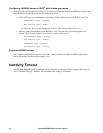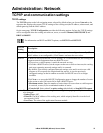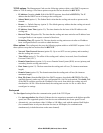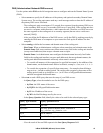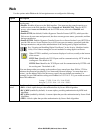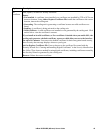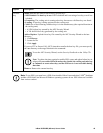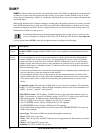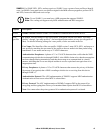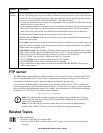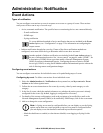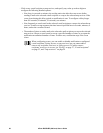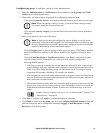
InRow RC/RD/RP (600 mm) User’s Guide44
Console
Use the options under Console on the left navigation menu to configure the following:
Option Description
access Choose one of the following:
• Disable: Disables all access to the control console.
• Enable Telnet (the default setting): Telnet transmits user names, passwords, and data
without encryption.
• Enable SSH v1/v2: Do not enable both versions 1 and 2 of Secure SHell (SSH) unless you
require that both be activated at the same time. (Security protocols use extensive processing
power.)
• Enable SSH v1 only: Secure SHell (SSH) version 1 transmits user names, passwords, and
data in encrypted form. There is little or no delay as you log on.
• Enable SSH v2 only: Secure SHell (SSH) version 2 transmits user names, passwords, and
data in encrypted form with somewhat more protection than version 1 from attempts to
intercept, forge, or alter data during transmission. There is a noticeable delay as you log on.
Identify the TCP/IP port used for communications with the cooling unit by Telnet and Secure
SHell (SSH).
• Telnet Port: The default is 23.
• SSH Port: The default is 22.
You can change the Port setting to the number of any unused port from 5000 to 32768 to
enhance the protection provided by User Name and Password settings.
• For Telnet, you must use either a colon (:) or a space in the command line, according to the
requirements of your Telnet client program, to specify the non-default port number. For
example, for a port number of 5000 and the cooling unit IP address of 152.214.12.114, your
Telnet client requires one of the following commands:
telnet 152.214.12.114:5000
telnet 152.214.12.114 5000
• For SSH, see the documentation for your SSH client for the command line format required
to specify a non-default port when starting SSH.
ssh
encryption
Enable or disable encryption algorithms (block ciphers) compatible with SSH version 1 or
version 2 clients:
SSH v1 algorithms:
• DES
• Blowfish: If your SSH v1 client cannot use Blowfish, which is always enabled, you must
also enable DES.
SSH v2 algorithms:
• 3DES: (enabled by default)
• Blowfish: (enabled by default)
• AES 128
• AES 256
Your SSH v2 client selects the enabled algorithm that provides the highest security. If your
SSH client cannot use the default algorithms, you must enable an AES algorithm that it can
use.



